 |
 |
 |
|
 |
|
|
|
|
|
|
|
|
|
Cineric - Type F - 9,5 mm; 1956
Bakelite case with a hinged door. the film path can be observed through glass window.
The mechanism is built on to a one piece aluminium pressure DI-cast panel: film path and lamp house on one side, motor and mechanism on the other. The operating side of the panel is finished in glossy white enamel.
In this model is fitted hinged type retainers which latched shut.
The arm are 900 ft capacity spool, which fold flat along top of case for caring and storage.
- Berthiot lens: 1:1,6/ F= 35 mm ;
- Variable speed control;
- Two switches: motor and lamp;
- lamp 110v 500W;
- Pilot lamp located in small housing directly above top sprocket.
Silent projector.
|
|
|
|
|
|
|
|
|
|
Dekko 9,5 mm projectors
In our collection we have three Dekko projectors: Dekko 1939, Dekko built after the war and Junior Dekko projector. The first Dekko model (not i our collection) was like the original Coronet projector, in style - look below, on this page.
Pict 1; Dekko 1939 & 1947 & Junior projectors in our collection; © Anna Vacani
Dekko Motor Driven 48 Model 1939
This projector is a rare model. It was advertised in December 1938 as “the 1939 Dekko motor driven 9,5 mm projector”. It was not produced during WWII.
The projector was produced by Dekko Cameras Ltd. Telford Way, London, W3. It is the first sprocket projector from Dekko. The two previous models were like a toy.
The construction
The base and lamp house are die cast. The rest of the construction being heavy pressed metal. Finish is black crackle enamel. The working parts are chromium plated.
Lamp
The lamp, in our projector, is A1/2 B15s base; 115v 50W. In other projectors the lamp can be 50 volt 25 watt, with concaved reflector behind, and conventional condenser system.
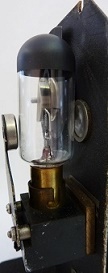 Pict 2; Lamp with reflector © Anna Vacani Pict 2; Lamp with reflector © Anna Vacani
Lens
The lens is unnamed and very simple in a Bakelite mount. This is a push fit in the housing on the body of the projector. Focusing is adjusted by moving the lens backwards and forwards.
Film transit mechanism
The projector is fitted with 300 ft arms, but was made for using either super or the 30/60 ft reels. For big reels, top and bottom arms are swung into place and locked with knurled head screws. After the spools fitting the spring belt drive from the arm pulley is placed in position (Pict 4;)
The film from the top spool passes down over a jockey roller and down under the feed sprocket, then a loop is made and the film is threaded down the film channel past the gate opening slightly for threading the film by moving a small lever. Next the film passes over another sprocket to the take up spool.
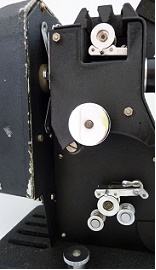 Pict 5; the gate and sprockets; © A. Vacani Pict 5; the gate and sprockets; © A. Vacani
The shutter is single bladed and revolves twice for each picture. There is no noticeable flicker. The shutter spins in between the lamp and the condenser. In this position it tends to reduced the amount of heat reaching the film gate and sets up air circulation round the lamp and assist the cooling.
Power
A small electric motor is mounted at the left side of the projector carcase. The projector speed is controlled by a rheostat knob, which operates a radial slider moving over a resistance inside the base.
Another slider is placed underneath the projector to be set to take supplies of 200, 230 and 250 volts. We have seen an advertisement (January 1939) quoting models with voltages from 100/110 AC DC.
The main switch is of the push through type, wired into main lead -Pict 3;. The projector can be hand drive by a crank directly fixed to the main pulley on the right side of the projector (Pict 4).
Rewind
The spring belt can be led up to the top spindle, or rewinding can be done by hand by the crank fixed to the main pulley(Pict 4) . It is necessary to open the gate channel by moving the lever, when this operation of rewinding is being carried out.
In January 1939 the projector was priced - £7 17 6.
It is silent projector.
The description was delivered on “Amateur Cine World” January 1939 edition - in our collection.
No production serial number.
Dekko Motor Driven 48 Model ca. 1947- 1948
Presumably, the projector was built up, after the war from parts left from prewar time. It looks as it was modified, possibly in the factory.
The modification done to this projector:
- the lamp and reflector fitting (compare with picture 2) is a little different. Outside of the lamp cover is fitted the alloy plate to prevent light spills and to allow adjustment to reflector position.
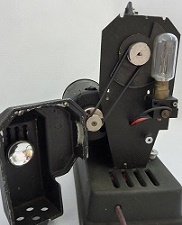 Pict 8; lamp and reflector; © A. Vacani Pict 8; lamp and reflector; © A. Vacani
- the mechanism of the motor and lamp switch on. It is fitted with two switches into the projector base - one for switch lamp and another for the motor (Pict 6). We think that improvement was fitted by last owner of the projector.
- it has fly wheel fitted on the shaft where previously was pulley for take up the belt and handle.
- the take up belt is now fitted to a position on the back of the main mechanism and the motor. It is substantial modification made in the factory (compare Pict 1).
No production serial number.
Dekko Junior Projector
The construction
The construction is the same as it is in models described above. The lamp cover is missing in our projector.
Lamp
The lamp is 50 volt 25 watt with base B 15s; type A1/1.
Lens
The lens is unnamed in a Bakelite mount as it is in model 1939. Focusing: Sliding lens mount.
Film transit mechanism
The projector takes 30/60 ft reels - cassette. It is claw type film transition.
Power
It is hand driven projector. Above the take up spool is a small handle for projection and rewinding.
 Pict 10; Dekko Junior - film transition; © Anna Vacani Pict 10; Dekko Junior - film transition; © Anna Vacani
In Amateur Cine World - January 1939 was an advertisement of this projector including Dekko Camera (in our collection):
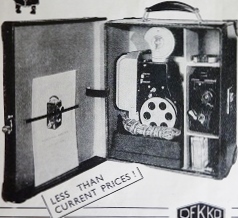 Pict 11; Dekko Junior projectors & Camera advert in ACW -Jan 1939 Pict 11; Dekko Junior projectors & Camera advert in ACW -Jan 1939
The projector does not a production serial number.
|
|
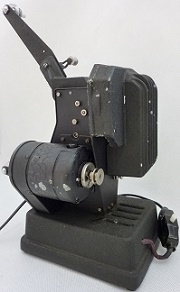
Pict 3; Dekko Motor Driven 1939;© A. Vacani
Pict 4; Dekko Motor Driven Projector - courtesy ACW January 1939
Pict 6;7; Dekko Motor Driven ca 1947- 1948; © A. Vacani
Pict 9; Dekko Junior projectors in our collection; © Anna Vacani
|
|
|
|
|
|
|
|
Pathe Mirage - 9,5 mm; c.1957
The projector features:
- Voltage 110 - 220;
- No claw mechanism only sprung peg and a roller beneath the gate.
- On the front of the projector is possible to remove a metal plate, and attach an unit to show 35 mm slides.
The projector construction is a very poor. It was not sold in the UK.
Made in France.
The production serial number: A11068
|
|
|
|
|
|
|
|
|
|
Noris - 9,5 mm; produced in Germany - 1952
The projector appeared on the English market before Christmas 1952. The price Was 18 gns (Guinea one pound and one shilling = today 1.05 pound).
The projector is well built and not so heavy - 5 1/2 lb (2,5 kg). Streamlined designed with finished Battleship Gray.
The projector features:
- lens without description;
- claw movement with automatic rewind;
- uses film lengths 30 ft - 400 ft; Some collectors say it is possible to use 900 ft spool, but it is not possible because the arm holds supply reel is to short for the 900 ft spool;
- lamp 100 watt 240 volt;
- power 200 - 250 AC or DC; the speed adjusting knob (described on the motor in four languages);
The speed knob
- lamphouse easily removed;
- hand operated for still pictures (the handle is missing);
Production number: 1765.
|
|
The original spool
|
|
|
|
|
|
|
|
Pathescope Kid - 9,5 mm - 1929
The projector was made by Pathescope; mechanical parts at Manchester works of the Salford Electrical Instrument Co., in England. The optical parts: lens, condenser and reflector) were made in France.
The body is made from pressings steel and is finished in black crackle enamel.
The features:
- double claw intermittent has its main driving cam concentric with a barrel shutter (equivalent to two blades - look into “Cine Dictionary” - on our site ‘Cine Collection’);
- latch mechanism that the claw drive is decoupled, when this device is triggered by a notch (for a title frame). The lower end of the claw carrier slid on the stud, with a small spring to take up and wear (and backlash). A button had to be pressed to re-engage the intermittent after reading the title.
- Lamp 12 v / 6 w, lamp fed via an external cylindrical resistance adjustable for all voltages between 110 and 250 v;
- slot type gate into which the end of the film is fed and the handle turned for threading; It is difficualt to remove accumulated emulsion on the gate, which does not have proper edge runners. The result is tendency to scrach film badly;
- it takes only 30 ft and 60 ft Pathe enclosed cassette. it is possibel to fit a British Pathe supper attachment for the larger 300 ft (100 m ) - came into the market in 1932.
Production No: u 9507
|
|
|
|
|
|
|
|
|
|
Coronet 9,5 mm - 1935-advertised in ‘Amateur Cine World’ in January 1935
The projector was made by the Coronet Camera Co, 310 Summer Lane, Birmingham 19, England. This company produced the cameras 9, 5 mm as well (look ‘cameras 9,5’ page 3).
Some cine specialists says, it was a simplification of the above projector - Pathescope Kid.
The body is made from pressed metal, finished in black crackle enamel. It is in a category of a toy projector.
The features:
- the simple two elements projection lens is in a “push-pull” Bakelite mount;
- takes the film 30 ft or 60 ft Pathe Baby cassette;
- In a large lamphouse is:
- 40 volt 15 watt lamp; with this powerful lamp the light is lost by a poor reflector- a simple metal pressed, instead of the optically worked mirror;
- resistance for all mains from 100 - 250 volts A.C. or D.C.; In 1935 it was supplied for running on 6v. accumulator;
- The film path is closed, with external lever to open the gate for threading and rewinding films;
- a barrel shutter (equivalent to two bladed type), incorporated with a simple intermittent operated by a “triangle in a square” cam behind the shutter blade; no spring loading to stabilize the motion;
- a small fly wheel is mounted on the back of the projector.
Silent projector
No visible production number
|
|
Lamphouse |
|
|
|
|
|
|
|
(1) (2) (3) (4) (5)
|
|
|
|
|
|
|
|
|
|
Page Back
|
|
|
|
|